By Lavina Melwani, Hinduism Today, Hawaii, January 1, 2004
All photos from BAPS
You can now travel to india without boarding a plane or even leaving your home in America! Indeed, you will think you have arrived in 17th-century India, but you are actually in a small, very American town—Robbinsville, New Jersey. In this bustling, fast-growing town, you drive through typical suburbia—homes, malls, fast-food places, auto dealerships—and then suddenly you make a turn and enter into a breathtaking India.
Behind vaulted high walls lies quite another world, quite another century. You are in the awe-aspiring BAPS Swaminarayan Temple complex, spread over 187 acres. Recently BAPS, a global spiritual organization, celebrated the grand opening of the Swaminarayan Akshardham, the largest Hindu mandir in the United States. It is said to be the second largest temple in the world, second only to the iconic Angkor Wat, which still stands as a testament to Hindu Dharma.
BAPS Swaminarayan Sanstha is a spiritual, volunteer-driven fellowship dedicated to improving society through individual growth by fostering the Hindu values of faith, service and global harmony. Its global network is comprised of more than 1,200 temples and 3,850 centers on five continents. They have over one million followers of which 55,000 volunteer much of their time to the organization’s operations. Based on the Vedic teachings propagated by Bhagwan Swaminarayan (1781-1830), it was formally established in 1907 by Brahmaswarup Shastriji Maharaj, and is currently led by Mahant Swami Maharaj (1933– ).
In his book on the building of the Robbinsville temple, If Stones Could Sing, Yogi Trivedi, explains why Hindu temples are so vital to our lives, as a visual expression of our faith: “Akshardham is a grand and at once nuanced representation of Hindu faith, history and lifestyle. Visual elements are a highly effective way to transmit these elements to subsequent generations. When spoken words could not be recorded and written manuscripts were brittle, these mandirs carried forth the story of a time and people to future generations. Each mandir carries the distinct cultural stamp of a people for future generations to remember and celebrate.”
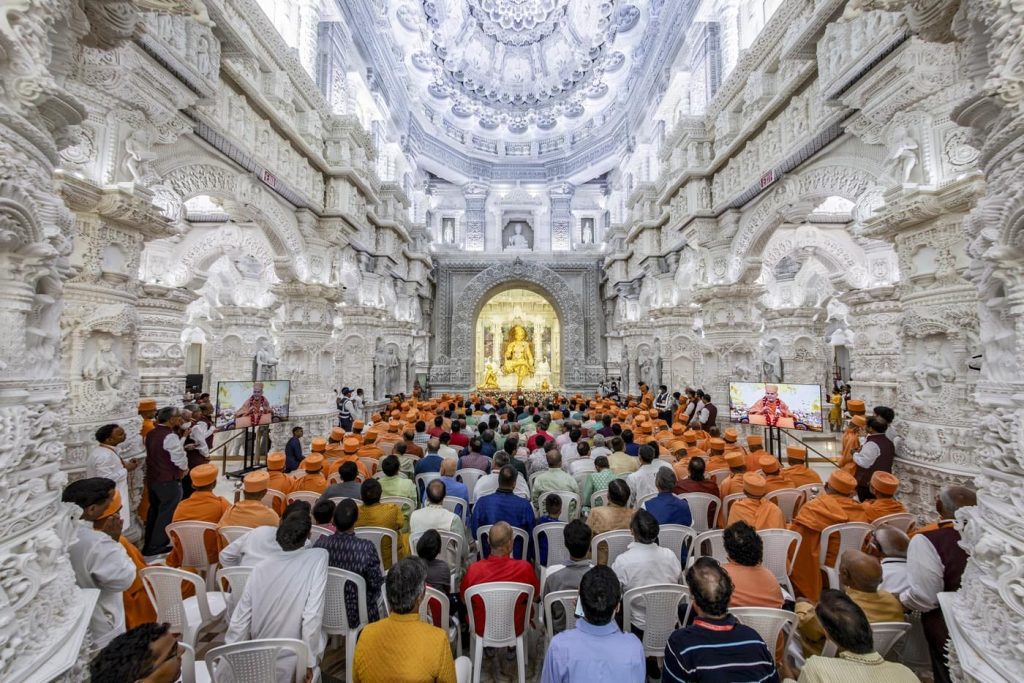
The central hall, with swamis and devotees attending the final consecration ceremonies conducted by Mahant Swami Mahara
In a world where birthday presents are typically received, His Holiness Mahant Swami Maharaj, the spiritual guru of BAPS, chose to give a remarkable gift to the world on his 90th birthday. In his blessings, Mahant Swami Maharaj stated, “It was Pramukh Swami Maharaj’s divine wish to construct an Akshardham in North America, where people can come and visit, irrespective of race, creed or religion.” Here, embedded like a jewel in pristine land, is the Mahamandir, a rhapsody in carved stone. The temple is a marvel: These stones traveled 21, 500 miles before reaching Akshardham. The final stone (amalak) was placed on the main steeple on June 16, 2023.

Shrine to Pramukh Swami Maharaj (1921–2016), founder of the Mahamandir
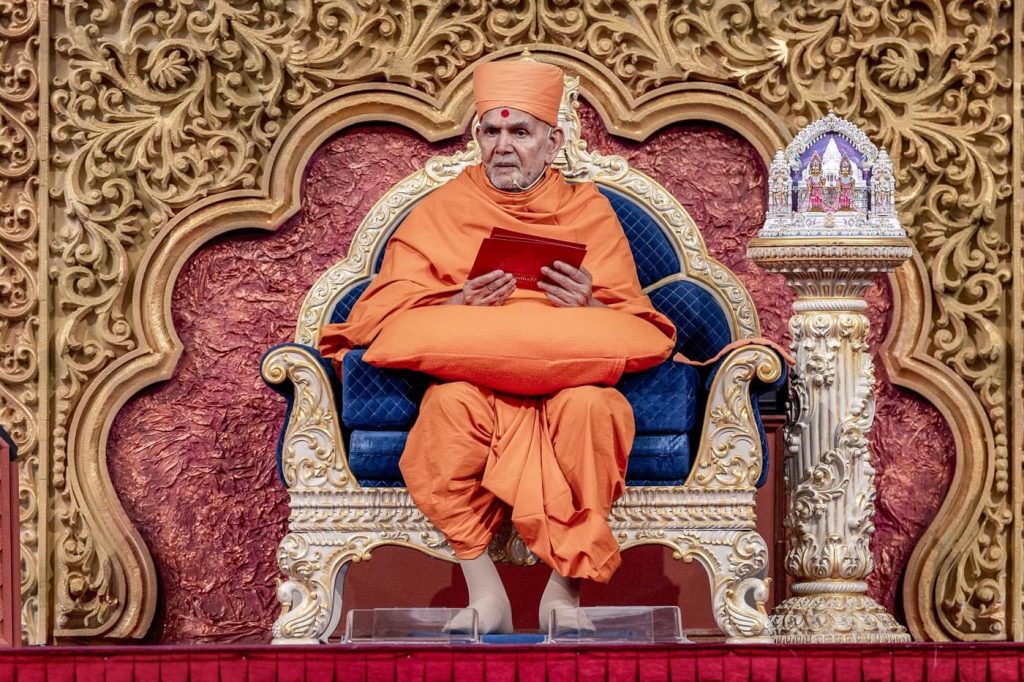
His successor, Mahant Swami Maharaj, addresses the devotees
Entering a Unique World
What is the special power that draws people here from so many towns and cities, so many countries? As you enter the complex, you enter a unique world. Set in manicured gardens, it is an entire city with flowing fountains, trees, flowers and sculptures. It is the place of worship for over 25,000 devotees of the Swaminarayan faith who live in this area, and it meets all their devotional, social and cultural needs.
As you enter the complex, your eye is immediately drawn to a towering 49-foot-tall gold-hued bronze murti of Bhagwan Swaminarayan’s child yogi form, Nilkanth Varni, dominating the gardens and symbolizing the internal steadiness achieved from the spiritual journey. People are drawn to the simple truths taught by this seer who lived in the 17th century. He taught about devotion and service to humanity, values which are the guiding principles of a good life even today.
Though the temple is devoted to the saints, the idea I found compelling was that, in a way, it is a temple devoted to ordinary people from all walks of life, for it is they who, through their devotion and service, have made it a living entity. It is a song to peace and love in a world that is often teetering towards war and destruction, terrorism and global warming, the plight of homeless refugees and the economically challenged.
In this beautiful and calm environment, all the world’s troubles seem far away. The message here is that the world is one family—water from over 300 rivers in India and across the world have been blended into the Brahma Kund, merging to celebrate the oneness of humanity. It is a large body of water inspired by the stepwells of western India, helping the visitor acclimatize to the sacred space, to wash away worries and burdens and enter a place of peace. The water in the Brahma Kund represents India’s four most sacred rivers—Ganga, Yamuna, Saraswati and Sarayu. The step pond includes waters from other sacred rivers in India and from all 50 US states.
A Landmark of Hindu Culture
One of the volunteers explains what the Mahamandir means to the larger world: “It’s truly a place of worship at its heart and core, but it’s also a landmark of Hindu architecture and culture for the entire Indian diaspora, for the entire world to come in and experience. It’s our neighbors, it’s our friends, it’s our family members who can come in and interact and engage with the culture, with the values. It doesn’t matter who you are—it’s irrespective of one’s background, race, religion, caste, you can come here to experience a part of Hinduism and a part of the Indian culture.”
Akshardham encompasses many meanings. As Yogi Trivedi, explained,“Akshardham is a mandir and a cultural center. At its core, Akshardham is a home for, or the abode of, the Divine, where millions will come to experience spiritual tranquility and cultural celebrations. Akshardham is a product of bhakti and seva in a visual, permanent form. It is also a hub for bhakti and seva to amplify their impact on society.”
The Welcome Center is built like a grand Gujarati haveli (mansion) out of carved Burmese teakwood. It serves many functions, such as spiritual assemblies, classes for the children to learn Gujarati, musical concerts, dancing and community gatherings. The handsome wooden columns are lit by 4,000 welcoming lights or diyas which are solar powered, keeping the needs of our changing world in mind.
The Mahamandir is exquisite, created from marble, granite and limestone. The statistics (sidebar, p. 33) are awe-aspiring. So many intricate stories are presented on its ceilings, domes and walls that you will find something new to contemplate every time you visit. The Mahamandir has so much symbolism built into it—it rests on the jagati or wisdom plinth—with messages from the holy texts, including the Ramayana and Bhagvata Gita and homage to great saints, poets and seers and philosophers, including the Sikh gurus, the Jain saint Mahavira and the Buddha.
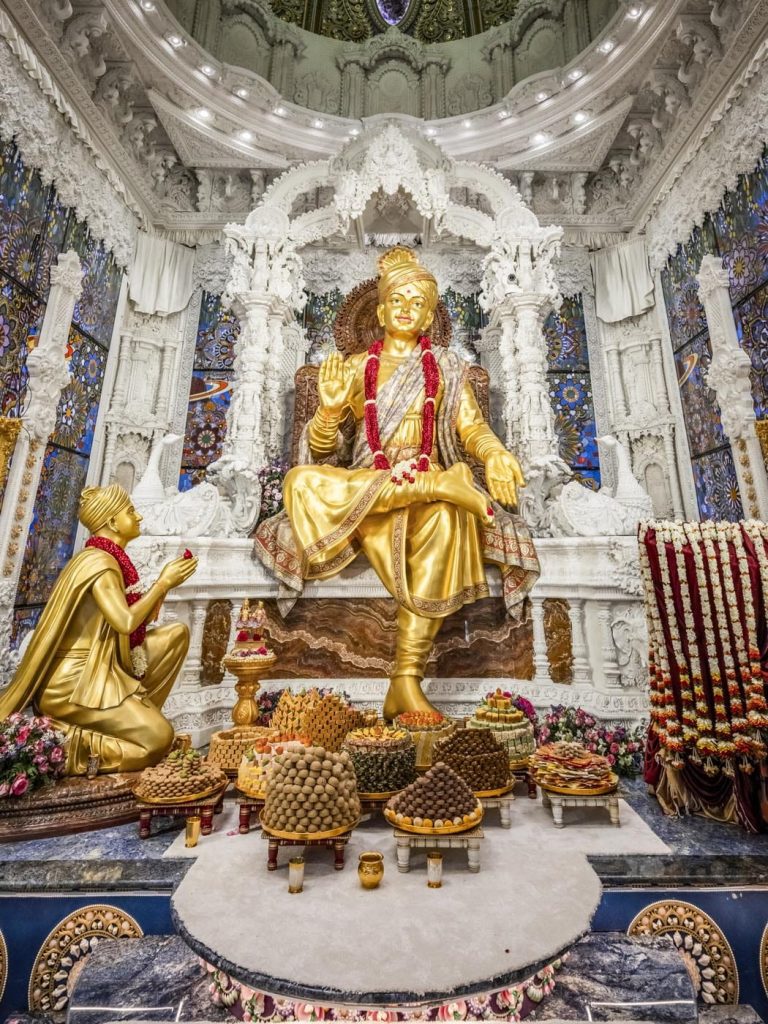
Central sanctum with Lord Swaminarayan (1781-1830) and Gunatitanand Swami (1784-1867) at His feet
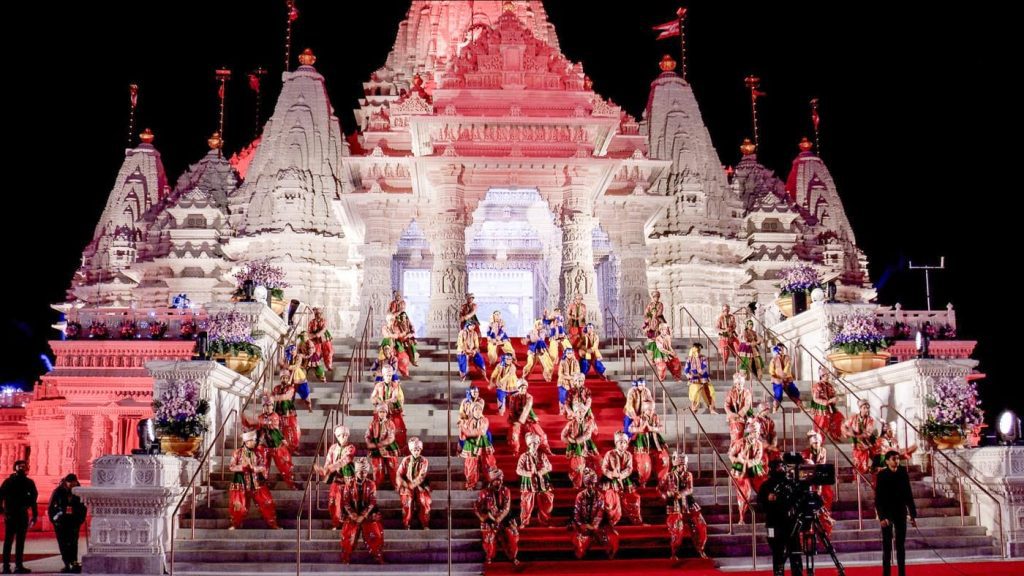
Dance performance on the temple’s steps
By the Numbers
Mahamandir Dimensions: 255 feet wide, 345 feet long and 191 feet tall
Construction area: 1.3 million sq. ft.
Cubic Feet of Stone: 1.9 million
Weight: 220 million pounds
Stone Pillars: 548
Stone Beams: 548
Statues and Statuettes: 10,000+
Carved Musical Instruments: 151
Bharatnatyam Dance Poses: 108
Inverted Domes: 9
Volunteers: 12,500
Volunteer Hours: Millions…
Volunteer guides explain that there is significance and symbolism behind every carving, starting from the first dome inside the Mahamandir, which depicts the eight holy rivers of India, in the form of Goddesses, and the eight holy pilgrimage places. All are there for future generations to see, carved into the structure of the Mahamandir.
The BAPS tradition normally places the saints in the center, while the Gods are at the side. In traditional Hindu temples, it’s the Gods who are the presiding Deities. As an outsider, I found that different, but it was reassuring to see the pantheon of Gods that one daily worships—Siva, Ganesh, Krishna—all had Their shrines. The more I learned about the saints, I understood and realized they had taught the people a special way to live. And people believe in them totally.
A Strong Tradition of Service
The story behind the temple is as powerful as the temple itself. Over the last 12 years, 12,500 volunteers came together to virtually transport this temple stone by stone and reconstruct it in New Jersey. So, while the stone was quarried from different parts of the world, it was all sent to India and carved there, then shipped across the oceans to Robbinsville. The actual temple was then constructed here, like a giant jigsaw puzzle. In addition to work by licensed contractors and artisans from India, thousands of dedicated volunteers put in millions of hours, often learning as they worked. They were not construction workers or laborers by trade, but white-collar professionals from many parts of the US and the world, including the UK, Canada and Australia. Scientists, doctors and lawyers put work aside, giving up their jobs to dedicate themselves to building the Mahamandir. Women gave up jobs or held fort in the house while their husbands worked in the construction. Women actually donned hard hats and worked in temple construction for the first time in their lives. Like the bowing peacocks carved on the walls, these high-powered professionals put their ego aside in the abode of God and did whatever was required of them to create the Mahamandir.
Yogi Trivedi points out the pioneering role of women volunteers in building the Mahamandir: “Women volunteered to waterproof the stones, operate Lull telehandlers (a type of forklift), assemble and build stone structures under the supervision of the skilled volunteers, and even led their own teams to install rebar for the concrete.”
As one woman volunteer told me, “Our guru lived his entire life in the service of others. He is our inspiration and our drive to be a part of something bigger than ourselves in connecting and unifying people. You think about that spirit, that you’re doing something that’s going to outlast your own life and will stand there for generations. That’s an inspiring thought, that you can be a part of making something that gives so many values and so many messages to so many people for thousands of years.”
Indeed, visiting the Mahamandir, one can’t help but be struck by the extraordinary ecosystem generated that puts service to others into the DNA of all the BAPS devotees and volunteers. It is something taught to all young people; it is a part of their growing-up years and the formation of their self identity. Young people serve joyfully in whatever service is assigned to them, be it organizing the shoes of the worshipers or cleaning the glass doors.
Others, coming from varied backgrounds and countries, find their calling as they learn about it through friends and join in the weekly spiritual assemblies. Said one volunteer who had come in from Dubai to serve in the opening of the Mahamandir, “I think because we’re so far away from India, we feel this unifying sense of strengthening our cultural identity when we come here. It allows you to thrive in your roots, while being very much a part of the society around you. So it’s not like we’re removing ourselves from another place but it’s about integrating and thriving collectively where we live.”
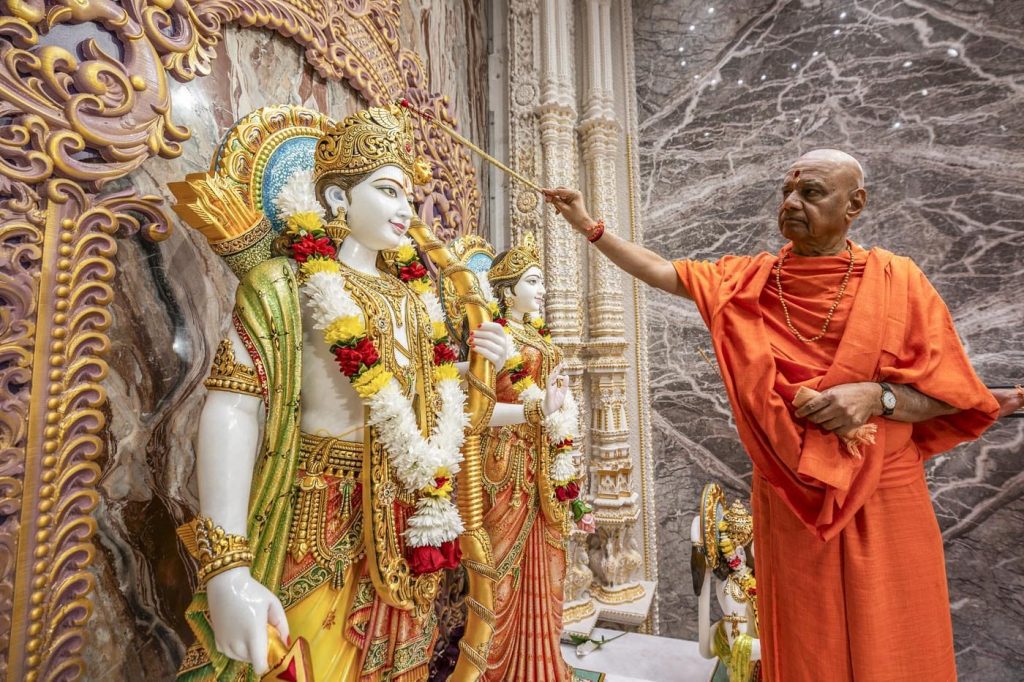
Swami blesses the statue of Lord Rama and Sita
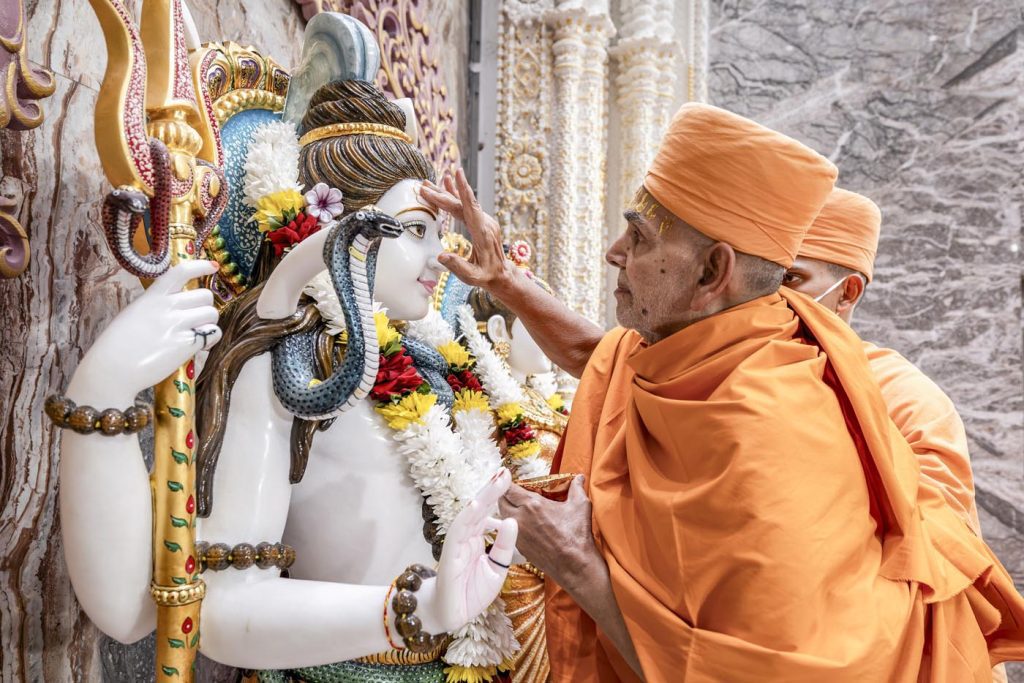
Similar blessing for Lord Siva and Goddess Parvati

Pouring the enormous concrete foundation slab, four feet thick, in 2014
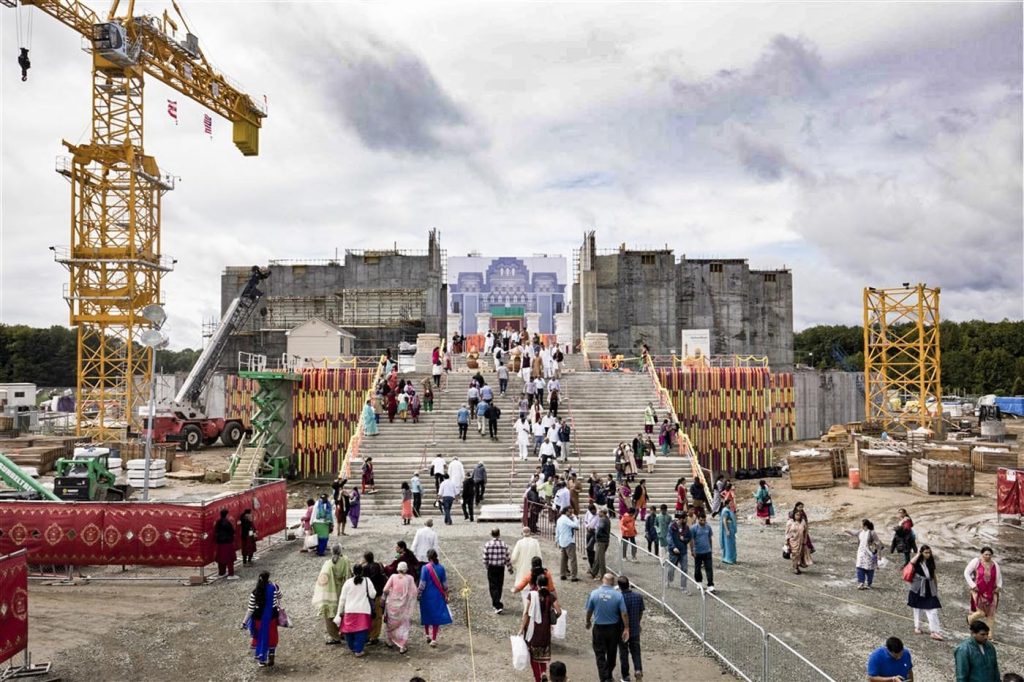
Three years later the temple is partway up
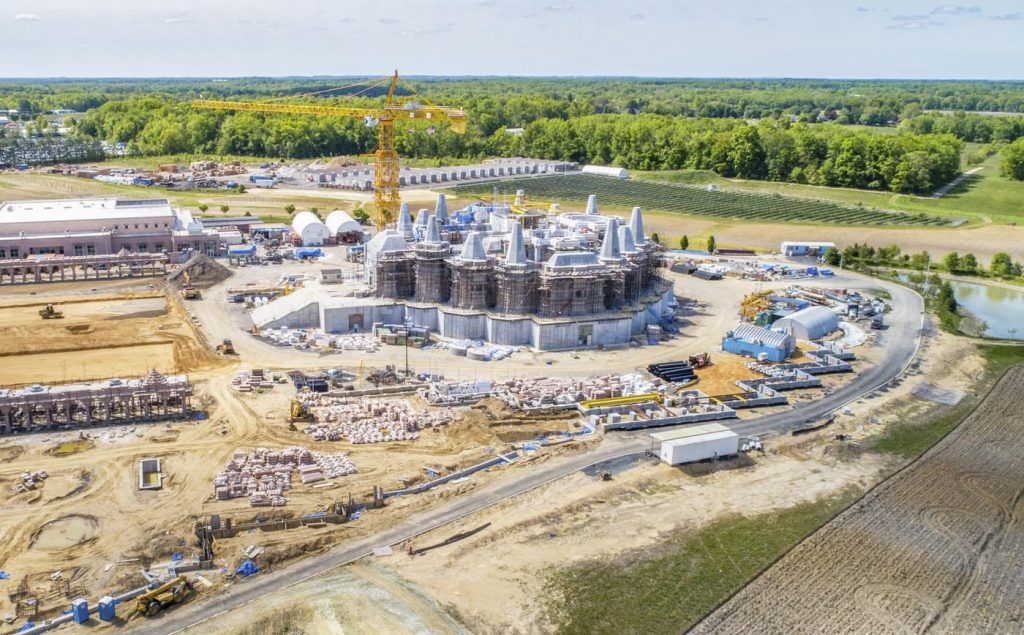
By 2021 all major pieces are taking shape
The Grand Opening
The grand opening of the Mahamandir started with the Festival of Inspirations on October 3, 2023. The several days of celebration culminated on October 8, the final day of pomp and circumstance, with a beautifully decorated temple, ceremonies and guests from all over the world. It was an extravaganza with illuminations, devotees singing and dancing and exuberant fireworks across the New Jersey skies. The entire event was live streamed for those who could not be there, and a summary video is available at: bit.ly/baps-10-8.
It is heartening to see that at the grand opening of the temple so many multi-faith leaders had been invited and came together as one big community. In the world, religion can be a source of conflict, such as in the Middle East, so it is a blessing when religious heads come together in peace and unity.
Many distinguished people spoke, and US Congressman Steny Hoyer of Maryland probably voiced the opinion of many: “This mandir is magnificent. We marvel at its immense size. We admire the craftsmanship behind the thousands of carved elephants, peacocks and other sculptures. But what I find most extraordinary is the community that built it. They did it because they believe in the values this structure represents: equality, liberation, truth, harmony and, most importantly, service to others. The values enshrined here are not just Hindu values, they are human values.”

Muti-faith gathering a few days before the consecration
Antidote to the World’s Ills
And so stands this mighty holy sacturary in America, in a typical small American town. As parts of the world around us descend into madness, the opening of the Mahamandir is an antidote to the bloodshed, the grief and the breakup of the human family. It reminds us not to give up what is good, but to celebrate the past and the stronger structures of humanity, service and values. It reminds people to donate of themselves, sharing themselves and linking to others, because the philosophy of the Mahamandir is to give and give and give.
As Yogi Trivedi sums it up, “As an awe-aspiring symbol for Hindu faith, culture and architecture, Akshardham serves as a place for all to belong, celebrate and selflessly articulate pride for their tradition while integrating open-mindedly within the America that we love and now call home. It will serve as a bridge between many countries, religions, and cultures for generations to come.”
Indeed, the Mahamandir is like a giant solar diya lamp which generates its light, its energy, from thousands and thousands of devotees and then lights up the world with service and spirituality for all humanity.
About the Author
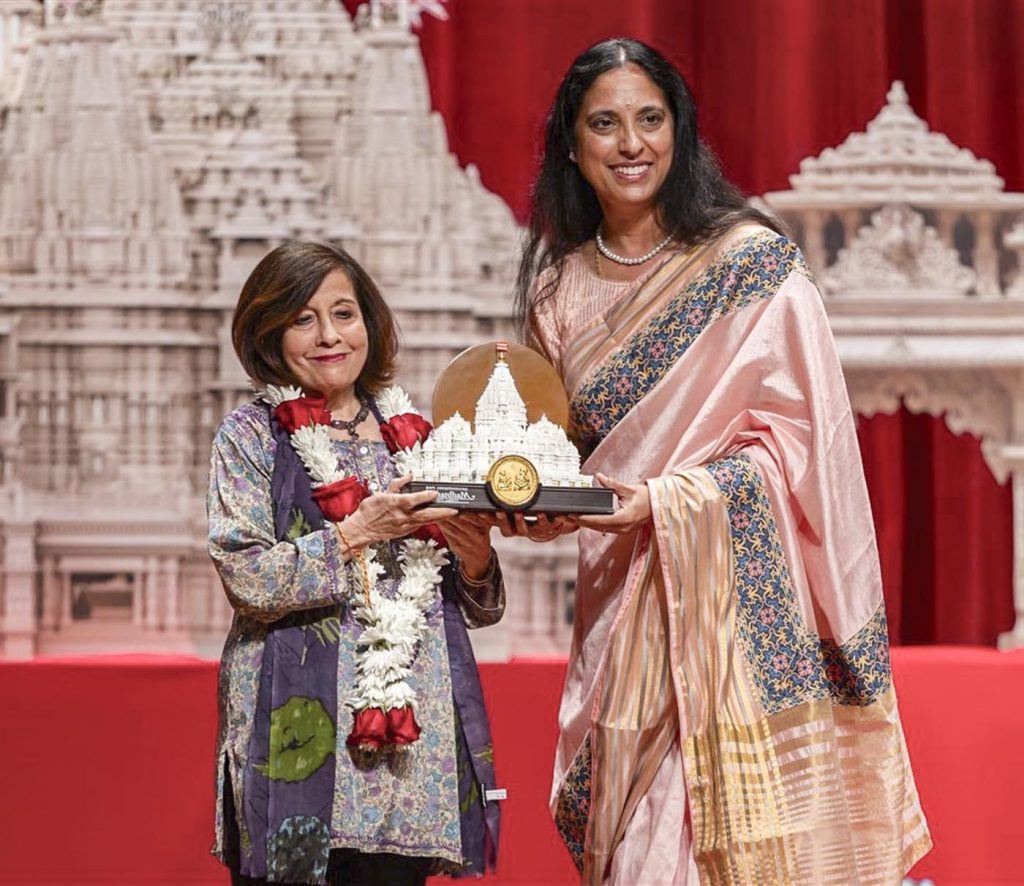
Lavina Melwani is a New York-based journalist who has written on the arts, spirituality and life for several international publications. She is a columnist for CNBCTV18.com and is a co-founder of Children’s Hope India. She blogs at www.lassiwithlavina.com. You can follow her @lavinamelwani.
As part of the nine-day temple dedication, BAPS held an event on October 3 called “Celebrating Women’s Contributions: Sanskars, Seva and Sanskruti” attended by hundreds of women, during which Lavina (at left) was given an award for her service to the Hindu community.
